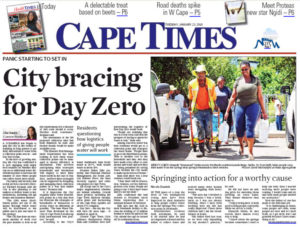Is Restricting Water Usage the Answer to Drought?
Following the driest first three months of a year in recorded history, last week California Governor Gavin Newsom signed another Executive Order calling on local water suppliers to move to Level 2 Water Shortage Contingency Plans CA Executive Order. This is preparation for a shortage of up to 20%. This comes on top of last year’s Executive Order asking Californians to reduce water usage by 15% as the state copes with persistent drought. So, we have to ask (and answer), is Restricting Water Usage the Answer to Drought?
Water restrictions are the standard response to drought conditions. After all, if you don’t have enough water you have to cut back, right? This approach is commonplace in nearly every populated arid region on the planet. Various levels or stages of water restrictions are declared. In Cape Town, South Africa in 2018, the metropolis of four million people came close to becoming the first major city in the world to run out of drinkable water. Video of thousands of people lining up to fill water jugs made for sensational global news.
 “Day Zero” in Cape Town – facing the first day without water
“Day Zero” in Cape Town – facing the first day without water
So, is restricting water usage the answer to drought? Clearly, if you are in the midst of severely reduced supply, the answer is yes – temporarily. But the real answer is there is no need to reach these crisis levels. The fact is, there is plenty of water available on the planet.
The U.S. National Groundwater Association estimates that there are 22,600,000 cubic kilometers of groundwater in the upper two kilometers of the earth’s crust. Each cubic kilometer is about 264 billion gallons. The world uses just 3,717 cubic kilometers of water per year. So, we have enough water in the ground to supply Earth for over 6,000 years at today’s global consumption rates. Even if we tapped just 10% of this water source, it would supply enough water for 600 years! Tapping less than two tenths of one percent of this water annually could provide nearly 17 gallons (64 liters) of additional fresh water per day to every man, woman, and child on the planet.
Using advanced technology to locate vast amounts of fresh underground water is now available to help solve the global water crisis. At AquaterreX, we have a unique combination of software algorithms, instrumentation, and other methods to locate these massive supplemental sources of water.
Now, I am not advocating the unrestricted use of water. Not only do we need to tap into the supplemental sources of water, but we also need to do a much better job of managing the water we are using now. Since about 70% of all fresh water is used for agriculture, better management approaches such as drip irrigation, soil remediation and other promising technologies can dramatically reduce the amount of water necessary for agriculture. In cities and towns, wastewater treatment and improved infrastructure will also have a dramatic impact on total consumption.
The fact is, we do not have to severely restrict water usage if we leverage all the tools at our disposal. There is plenty of water available on the planet and we now know how to find it. We also have newer best practices that can make a dramatic difference in total usage. If we start acting now, in a short time the headlines about “Water Restrictions” and grotesque pictures of dead animals and starving children can be replaced with headlines about more food production, smarter use of water and less conflict.
James D’Arezzo
Chairman & CEO
AquaterreX
Related Tags: Drought Solutions
Originally published on Jul 16, 2021, updated April 7, 2022 due to new executive order concerning restricting water during drought.